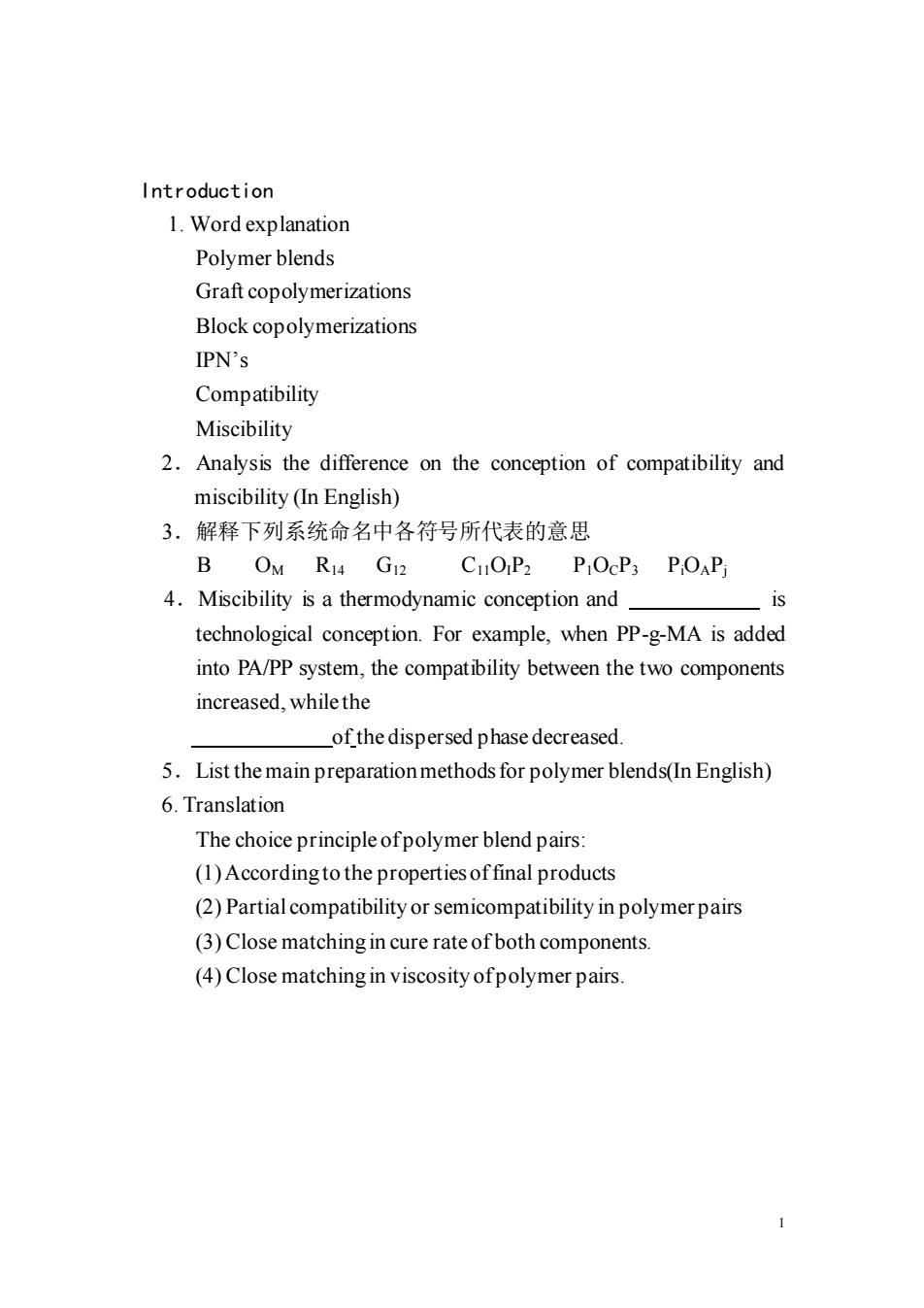
Introduction 1.Word explanation Polymer blends Graft copolymerizations Block copolymerizations IPN's Compatibility Miscibility 2.Analysis the difference on the conception of compatibility and miscibility(In English) 3.解释下列系统命名中各符号所代表的意思 B OM RI4 G12 CnOP2 PiOcP3 POAP 4.Miscibility is a thermodynamic conception and technological conception.For example,when PP-g-MA is added into PA/PP system,the compatibility between the two components increased,whilethe of the dispersed phase decreased 5.List the main preparationmethods for polymer blends(In English) 6.Translation The choice principle ofpolymer blend pairs: (1)Accordingto the propertiesoffinal products (2)Partial compatibility or semicompatibility in polymer pairs (3)Close matching in cure rate of both components. (4)Close matching in viscosity ofpolymer pairs
1 Introduction 1. Word explanation Polymer blends Graft copolymerizations Block copolymerizations IPN’s Compatibility Miscibility 2.Analysis the difference on the conception of compatibility and miscibility (In English) 3.解释下列系统命名中各符号所代表的意思 B OM R14 G12 C11OIP2 P1OCP3 PiOAPj 4.Miscibility is a thermodynamic conception and is technological conception. For example, when PP-g-MA is added into PA/PP system, the compatibility between the two components increased, while the of the dispersed phase decreased. 5.List the main preparation methods for polymer blends(In English) 6. Translation The choice principle of polymer blend pairs: (1) According to the properties of final products (2) Partial compatibility or semicompatibility in polymer pairs (3) Close matching in cure rate of both components. (4) Close matching in viscosity of polymer pairs
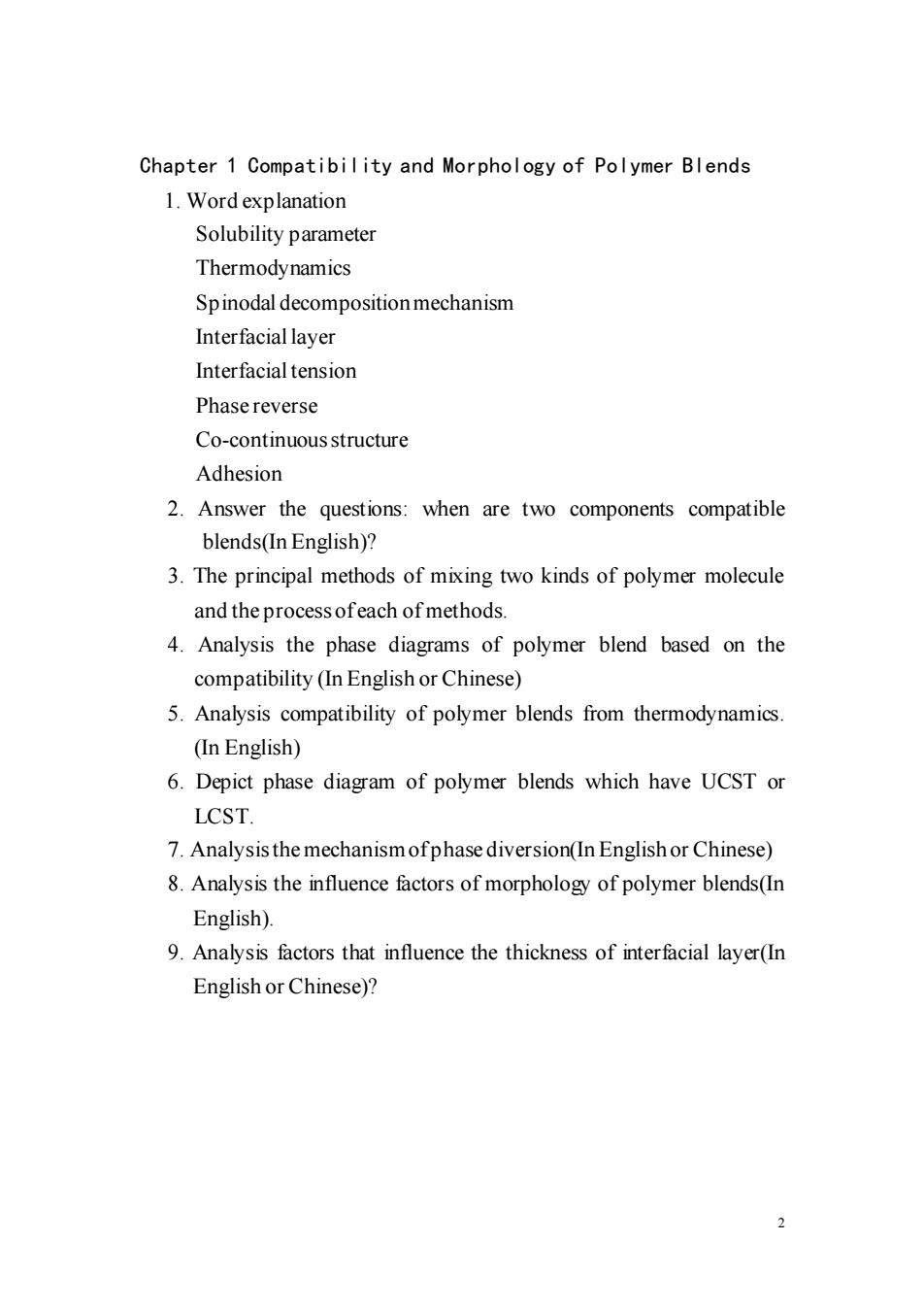
Chapter 1 Compatibility and Morphology of Polymer Blends 1.Word explanation Solubility parameter Thermodynamics Spinodal decomposition mechanism Interfacial layer Interfacial tension Phase reverse Co-continuousstructure Adhesion 2.Answer the questions:when are two components compatible blends(In English)? 3.The principal methods of mixing two kinds of polymer molecule and the process ofeach of methods. 4.Analysis the phase diagrams of polymer blend based on the compatibility(In English or Chinese) 5.Analysis compatibility of polymer blends from thermodynamics (In English) 6.Depict phase diagram of polymer blends which have UCST or LCST 7.Analysis the mechanismofphase diversion(In English or Chinese) 8.Analysis the influence factors of morphology of polymer blends(In English). 9.Analysis factors that influence the thickness of interfacial layer(In English or Chinese)?
2 Chapter 1 Compatibility and Morphology of Polymer Blends 1. Word explanation Solubility parameter Thermodynamics Spinodal decomposition mechanism Interfacial layer Interfacial tension Phase reverse Co-continuous structure Adhesion 2. Answer the questions: when are two components compatible blends(In English)? 3. The principal methods of mixing two kinds of polymer molecule and the process of each of methods. 4. Analysis the phase diagrams of polymer blend based on the compatibility (In English or Chinese) 5. Analysis compatibility of polymer blends from thermodynamics. (In English) 6. Depict phase diagram of polymer blends which have UCST or LCST. 7. Analysis the mechanism of phase diversion(In English or Chinese) 8. Analysis the influence factors of morphology of polymer blends(In English). 9. Analysis factors that influence the thickness of interfacial layer(In English or Chinese)?
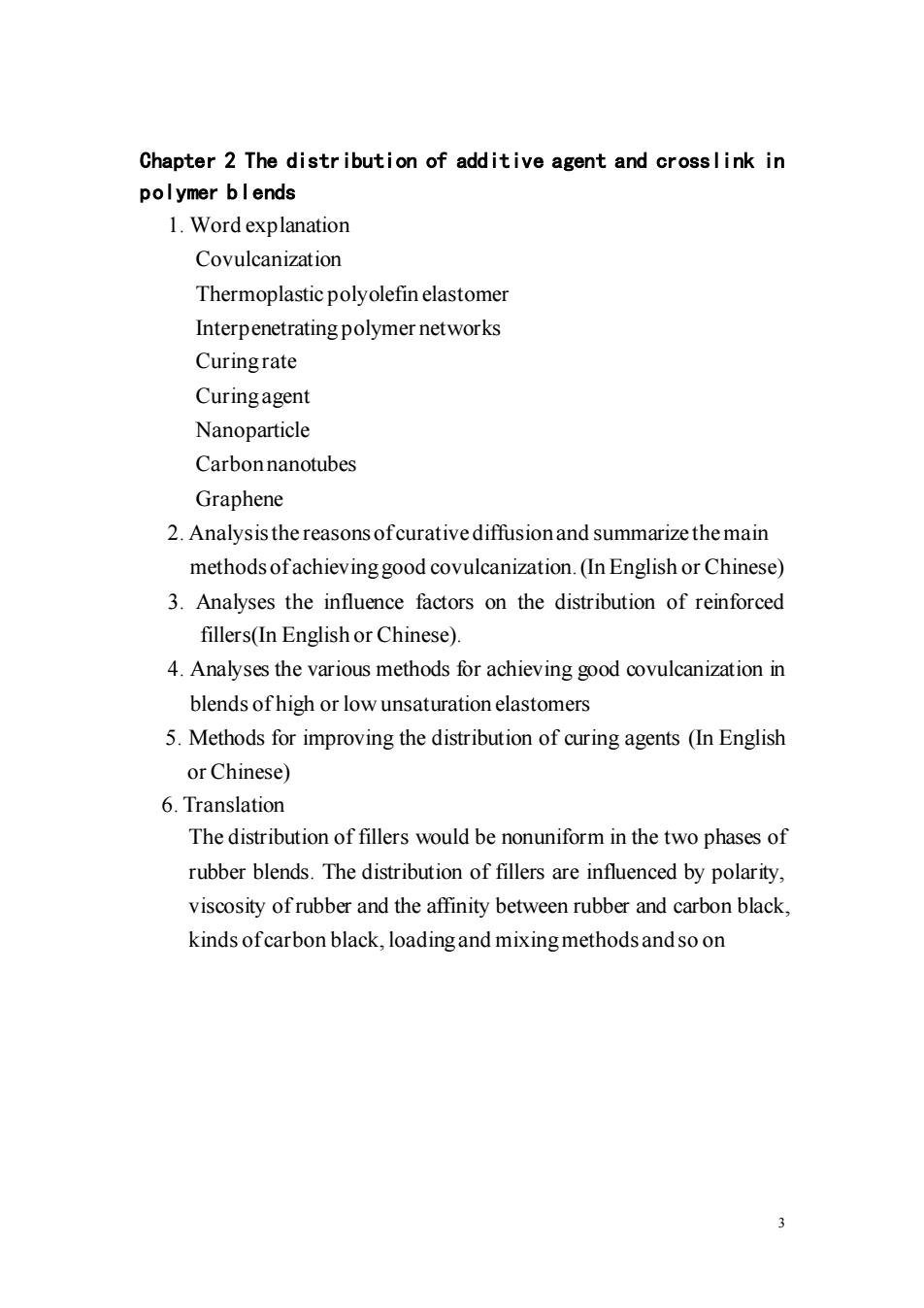
Chapter 2 The distribution of additive agent and crosslink in polymer blends 1.Word explanation Covulcanization Thermoplastic polyolefin elastomer Interpenetrating polymer networks Curingrate Curingagent Nanoparticle Carbonnanotubes Graphene 2.Analysis the reasons ofcurativediffusionand summarize the main methods ofachieving good covulcanization.(In English or Chinese) 3.Analyses the influence factors on the distribution of reinforced fillers(In English or Chinese). 4.Analyses the various methods for achieving good covulcanization in blends ofhigh or low unsaturation elastomers 5.Methods for improving the distribution of curing agents(In English or Chinese) 6.Translation The distribution of fillers would be nonuniform in the two phases of rubber blends.The distribution of fillers are influenced by polarity, viscosity of rubber and the affinity between rubber and carbon black kinds ofcarbon black,loading and mixing methods and so on
3 Chapter 2 The distribution of additive agent and crosslink in polymer blends 1. Word explanation Covulcanization Thermoplastic polyolefin elastomer Interpenetrating polymer networks Curing rate Curing agent Nanoparticle Carbon nanotubes Graphene 2. Analysis the reasons of curative diffusion and summarize the main methods of achieving good covulcanization. (In English or Chinese) 3. Analyses the influence factors on the distribution of reinforced fillers(In English or Chinese). 4. Analyses the various methods for achieving good covulcanization in blends of high or low unsaturation elastomers 5. Methods for improving the distribution of curing agents (In English or Chinese) 6. Translation The distribution of fillers would be nonuniform in the two phases of rubber blends. The distribution of fillers are influenced by polarity, viscosity of rubber and the affinity between rubber and carbon black, kinds of carbon black, loading and mixing methods and so on
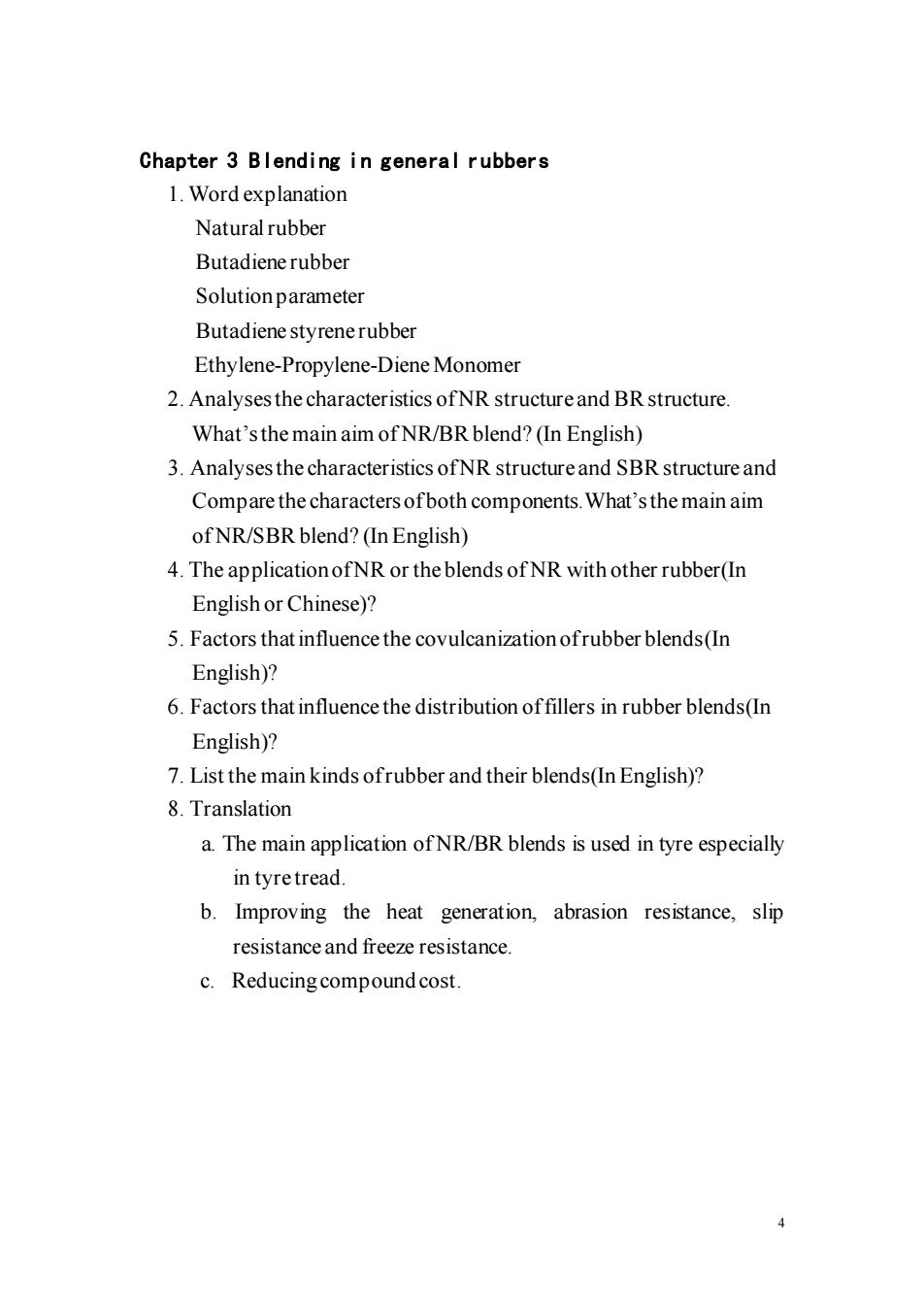
Chapter 3 Blending in general rubbers 1.Word explanation Natural rubber Butadienerubber Solutionparameter Butadiene styrenerubber Ethylene-Propylene-Diene Monomer 2.Analyses the characteristics ofNR structure and BR structure. What's the main aim of NR/BR blend?(In English) 3.Analyses the characteristics ofNR structure and SBR structure and Compare the characters ofboth components.What's the main aim of NR/SBR blend?(In English) 4.The applicationofNR or the blends of NR with other rubber(In English or Chinese)? 5.Factors that influence the covulcanization ofrubber blends(In English)? 6.Factors that influence the distribution offillers in rubber blends(In English)? 7.List the main kinds ofrubber and their blends(In English)? 8.Translation a.The main application of NR/BR blends is used in tyre especially in tyretread. b.Improving the heat generation,abrasion resistance,slip resistance and freeze resistance. c.Reducingcompoundcost
4 Chapter 3 Blending in general rubbers 1. Word explanation Natural rubber Butadiene rubber Solution parameter Butadiene styrene rubber Ethylene-Propylene-Diene Monomer 2. Analyses the characteristics of NR structure and BR structure. What’s the main aim of NR/BR blend? (In English) 3. Analyses the characteristics of NR structure and SBR structure and Compare the characters of both components.What’s the main aim of NR/SBR blend? (In English) 4. The application of NR or the blends of NR with other rubber(In English or Chinese)? 5. Factors that influence the covulcanization of rubber blends(In English)? 6. Factors that influence the distribution of fillers in rubber blends(In English)? 7. List the main kinds of rubber and their blends(In English)? 8. Translation a. The main application of NR/BR blends is used in tyre especially in tyre tread. b. Improving the heat generation, abrasion resistance, slip resistance and freeze resistance. c. Reducing compound cost
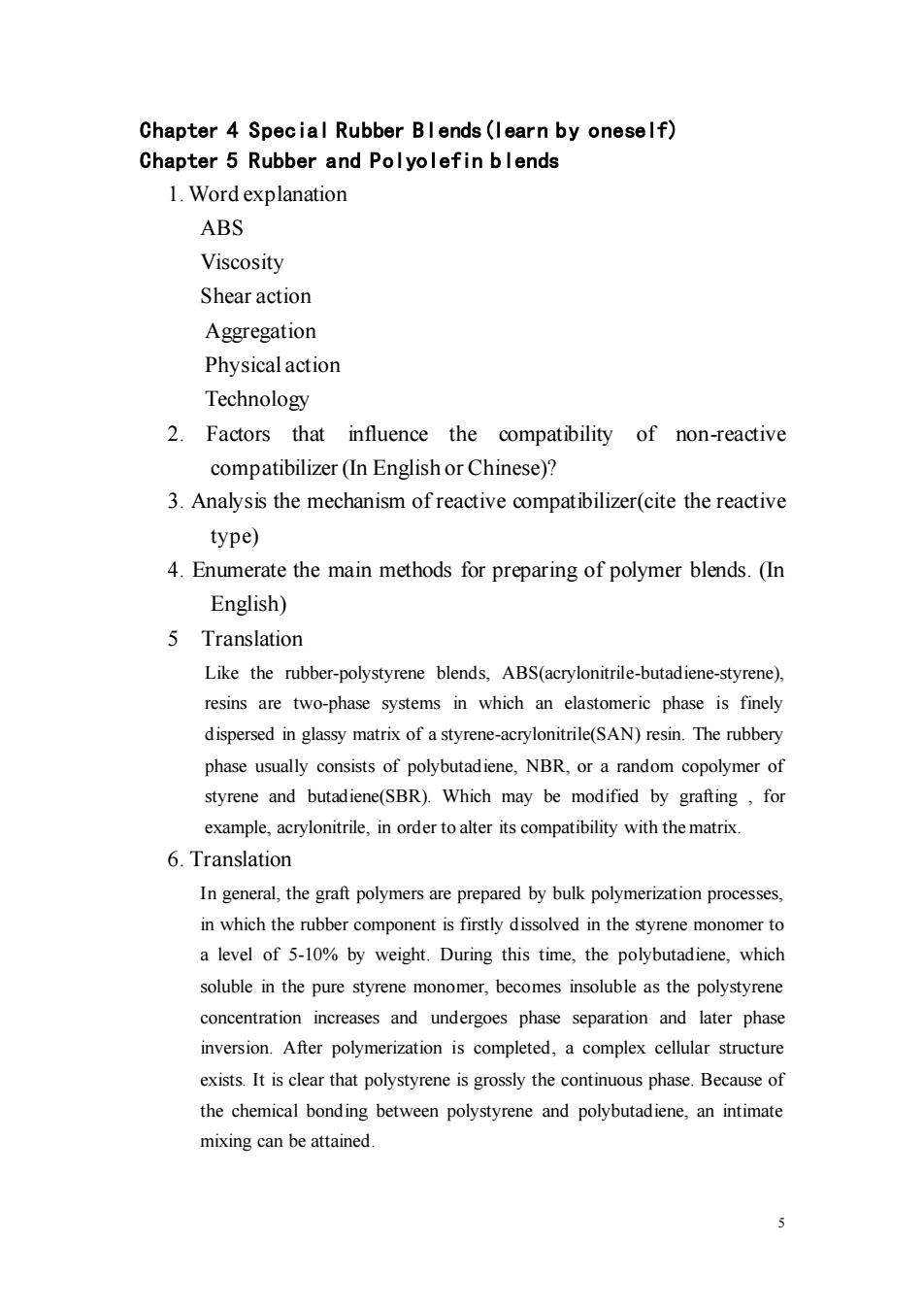
Chapter 4 Special Rubber Blends(learn by oneself) Chapter 5 Rubber and Polyolefin blends 1.Word explanation ABS Viscosity Shear action Aggregation Physical action Technology 2.Factors that influence the compatibility of non-reactive compatibilizer(In English or Chinese)? 3.Analysis the mechanism of reactive compatibilizer(cite the reactive type) 4.Enumerate the main methods for preparing of polymer blends.(In English) 5 Translation Like the rubber-polystyrene blends,ABS(acrylonitrile-butadiene-styrene). resins are two-phase systems in which an elastomeric phase is finely dispersed in glassy matrix of a styrene-acrylonitrile(SAN)resin.The rubbery phase usually consists of polybutadiene,NBR,or a random copolymer of styrene and butadiene(SBR).Which may be modified by grafting,for example,acrylonitrile.in order to alter its compatibility with the matrix 6.Translation In general,the graft polymers are prepared by bulk polymerization processes, in which the rubber component is firstly dissolved in the styrene monomer to a level of 5-10%by weight.During this time,the polybutadiene,which soluble in the pure styrene monomer,becomes insoluble as the polystyrene concentration increases and undergoes phase separation and later phase inversion.After polymerization is completed,a complex cellular structure exists.It is clear that polystyrene is grossly the continuous phase.Because of the chemical bonding between polystyrene and polybutadiene,an intimate mixing can be attained
5 Chapter 4 Special Rubber Blends(learn by oneself) Chapter 5 Rubber and Polyolefin blends 1. Word explanation ABS Viscosity Shear action Aggregation Physical action Technology 2. Factors that influence the compatibility of non-reactive compatibilizer (In English or Chinese)? 3. Analysis the mechanism of reactive compatibilizer(cite the reactive type) 4. Enumerate the main methods for preparing of polymer blends. (In English) 5 Translation Like the rubber-polystyrene blends, ABS(acrylonitrile-butadiene-styrene), resins are two-phase systems in which an elastomeric phase is finely dispersed in glassy matrix of a styrene-acrylonitrile(SAN) resin. The rubbery phase usually consists of polybutadiene, NBR, or a random copolymer of styrene and butadiene(SBR). Which may be modified by grafting , for example, acrylonitrile, in order to alter its compatibility with the matrix. 6. Translation In general, the graft polymers are prepared by bulk polymerization processes, in which the rubber component is firstly dissolved in the styrene monomer to a level of 5-10% by weight. During this time, the polybutadiene, which soluble in the pure styrene monomer, becomes insoluble as the polystyrene concentration increases and undergoes phase separation and later phase inversion. After polymerization is completed, a complex cellular structure exists. It is clear that polystyrene is grossly the continuous phase. Because of the chemical bonding between polystyrene and polybutadiene, an intimate mixing can be attained